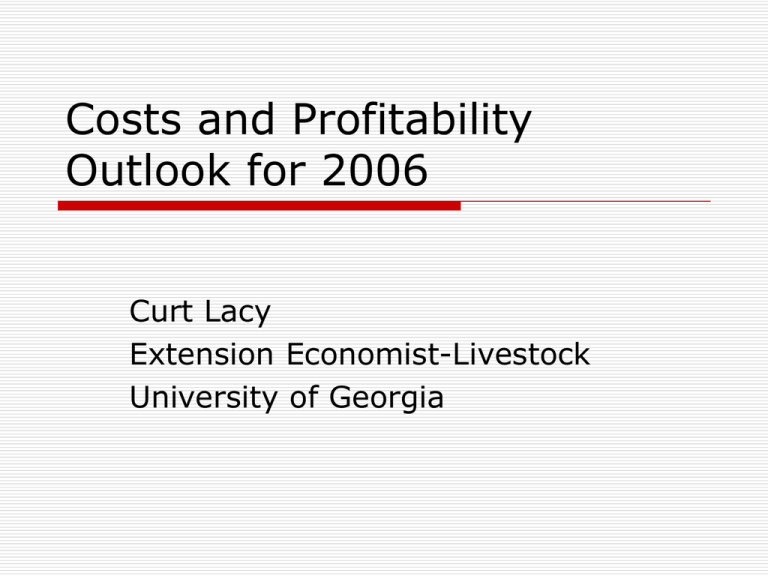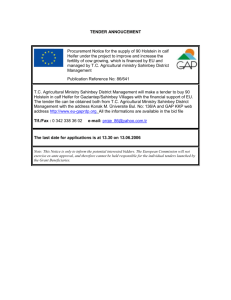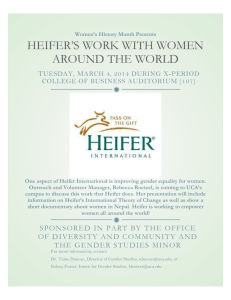Costs and Profitability Outlook for 2006 Curt Lacy Extension Economist-Livestock
advertisement

Costs and Profitability Outlook for 2006 Curt Lacy Extension Economist-Livestock University of Georgia $ Per Cow COW-CALF RETURNS AND CATTLE INVENTORY U.S., Annual Mil. Head 150 140 100 130 50 120 0 110 -50 100 -100 90 C-P-67 1976 1978 1980 1982 1984 1986 1988 1990 1992 1994 1996 1998 2000 2002 2004 Cow-Calf Returns Cattle Inventory Jan 1 07/27/05 Fertilizer Prices – 1997-2005 A.N. prices have increased 46% since 2002 $350 $300 $200 $150 $100 $50 Nitrogen (AN) Phosphorous (DAP) Department of Agricultural & Applied Economics 2 0 0 5 2 0 0 4 2 0 0 3 2 0 0 2 2 0 0 1 2 0 0 0 1 9 9 9 1 9 9 8 $0 1 9 9 7 $/ton $250 Potash (Muriate) Impact of Changes in Nitrogen and Potash on Hay Fertilizer Costs Per Acre* Nitrogen $ 0.30 $ 0.40 $ 0.45 $ 0.50 $ 0.60 Potash $ 0.15 $ 0.20 $ 117.00 $ 126.00 $ 141.00 $ 150.00 $ 153.00 $ 162.00 $ 165.00 $ 174.00 $ 189.00 $ 198.00 $ 0.25 $ 135.00 $ 159.00 $ 171.00 $ 183.00 $ 207.00 *Excludes all other costs Department of Agricultural & Applied Economics $ 0.30 $ 144.00 $ 168.00 $ 180.00 $ 192.00 $ 216.00 Impact of Changes in Nitrogen and Potash on Hay Fertilizer Costs Per Ton* Nitrogen $ 0.30 $ 0.40 $ 0.45 $ 0.50 $ 0.60 Yield (Tons/Acre) 3.00 5.00 $ 43.80 $ 26.28 $ 51.80 $ 31.08 $ 55.80 $ 33.48 $ 59.80 $ 35.88 $ 67.80 $ 40.68 *Excludes all other costs Department of Agricultural & Applied Economics $ $ $ $ $ 7.00 18.77 22.20 23.91 25.63 29.06 Fuel Prices – 1997-2005 Diesel prices are up 104% since 2002 $2.50 $1.50 $1.00 $0.50 Diesel (bulk) Department of Agricultural & Applied Economics 2 0 0 5 2 0 0 4 2 0 0 3 2 0 0 2 2 0 0 1 2 0 0 0 1 9 9 9 1 9 9 8 $0.00 1 9 9 7 $/Gallon $2.00 Impact of Fuel & Fertilizer Prices on Cost of Production $90 $80 $70 $60 $50 $40 $30 $20 2002 500# Calf ($/Cwt.) 2005 Hay ($/ton) Department of Agricultural & Applied Economics Impact of Fuel Costs on Hay Costs Per Acre* 90 80 $/Acre 70 60 50 40 30 20 10 0 *Excludes all other costs 1 2 3 Cuttings/Year $1.50 $1.75 $2.00 $2.25 Department of Agricultural & Applied Economics $2.50 Replacement Heifer Development Costs Item Heifer Heifer Development Budget Unit Cost/unit Quantity Item cost cwt. $ 100.00 5.5 $ 550.00 Winter Pasture ac $ 135.00 0.67 $ 90.00 Coastal Pasture ac $ 140.00 0.67 $ 93.80 Other Pasture ac $ - 0.67 $ - Hay ton $ 65.00 1.65 $ 107.25 Feed - Developing Heifer lbs $ 0.05 540 $ 27.00 Feed - Pregnant Heifer lbs $ 0.05 300 $ 15.00 Feed - 1st Calf Heifer lbs $ - $ - Other Feed lbs $ - $ - Mineral hd $ 18.20 1 $ 18.20 Ear Tags hd $ 2.80 1 $ 2.80 Vet & Med - Vaccinations hd $ 6.12 1 $ 6.12 Vet & Med - Preg check hd $ 3.00 1 $ 3.00 Labor hrs $ 9.00 1.5 $ 13.50 Total Variable Costs Interest hd hd 7.00% $ 463.34 $ $ 926.67 32.43 Bull Costs hd 19.20 1.00 $ 19.20 Non-breeders percent 15.00% $ 959.10 $ 143.87 Total Costs of Retaining Heifers hd $ 1,122.17 Adjustment for cull heifer sales hd 800 $ 102.00 $ 1,020.17 Total net costs for retaining heifer $ $ 85.00 $ Replacement Female Considerations Current economic value = -$218.77 Breakeven purchase price = $801.40 Years to breakeven = 7 Department of Agricultural & Applied Economics Expected Profits and Breakeven Prices Item Net Returns (Total) Net Breakeven Returns ($/Cwt.) ($/weaned Calf) Variable Costs $6,495.64 $76.42 $85.41 Total Costs -$8,352.60 -$98.27 $116.55 Department of Agricultural & Applied Economics Now What? Where can you increase profits? Increase conception rates Decrease Variable Costs What is your hay cost Where do you store your hay? Do you have alternative fertilizer sources Legumes Soil ph Decrease Fixed Costs – Equipment & Females Cull unproductive cows Purchase hay? Custom hiring hay Can you do custom work? Increasing herd size lease cows instead of raising heifers Department of Agricultural & Applied Economics Good News-Bad News Most cow-calf producers should be able to cover their cash expenses for the next few years Cost of production for beef cattle producers has risen considerably in the last 2-3 years Fuel & fertilizer prices alone have risen from 46%-105% Many will not be able to cover all expenses Producers should focus on increasing weaning %, culling unproductive cows and reducing fertilizer and fuel needs Department of Agricultural & Applied Economics

